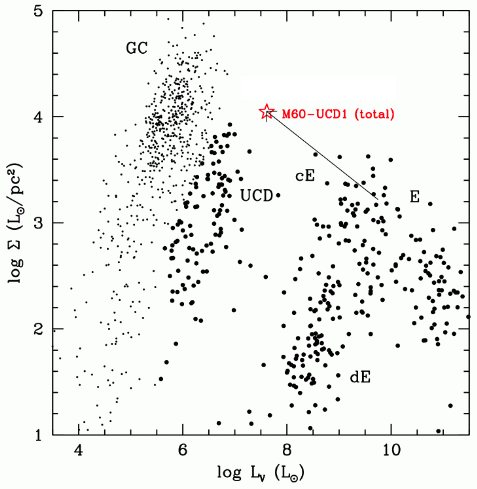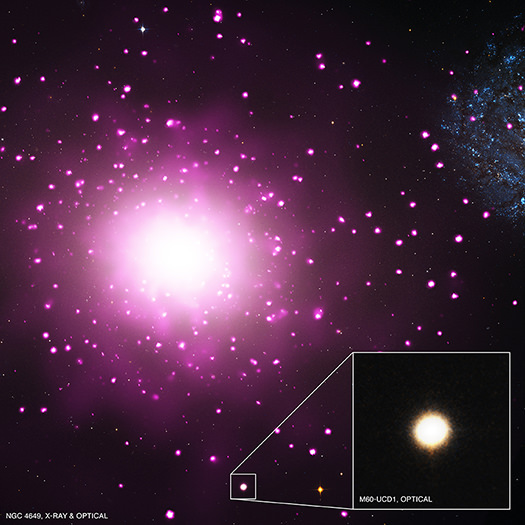Meet galaxy M60-UCD1. This is not your average, every day, ordinary galaxy. First of all, it’s what is known as an ‘ultra-compact dwarf galaxy,’ which – as the name implies — are unusually dense and small galaxies. Additionally, it is the most luminous known galaxy of its type and one of the most massive, weighing 200 million times more than our Sun. But M60-UCD1 is jam-packed with an extraordinary number of stars, making it the densest galaxy in the nearby Universe that we know of. Stars in M60-UCD1 are thought to be 25 times closer together than the stars in our galaxy.
Quick and easy access to neighboring star systems (if you lived there) might be your first thought. But remember, space is big, no matter where you are.
“Traveling from one star to another would be a lot easier in M60-UCD1 than it is in our galaxy,” said Jay Strader of Michigan State University in Lansing, first author of a paper describing these results. “But it would still take hundreds of years using present technology.”
Ultra-compact dwarf galaxies were discovered about a decade ago. They are typically about only 100 light years across compared to the 1,000 light years or more than other dwarf galaxies. Our Milky Way galaxy is 120,000 light-years across.

Strader said that what makes M60-UCD1 so remarkable is that about half of its mass is found within a radius of only about 80 light years. This would make the density of stars about 15,000 times greater than found in Earth’s neighborhood in the Milky Way.
“Our discovery of M60-UCD1 lends support to the idea that ultra-compact dwarfs could be stripped-down version of more massive galaxies,” Strader wrote in a post on the Chandra blog. “The first reason is its mass: we estimate that it contains about 400 million stars, far more than observed for even massive star clusters, and much closer to the galaxy regime. We also observe that M60-UCD1 has two “parts”: an inner, even denser core embedded in a more diffuse field of stars. This structure is not expected for a star cluster, but it’s a natural outcome of the tidal stripping process that could produce an ultra-compact dwarf.”
And so, this UCD is providing astronomers with clues to how these types of galaxies fit into the galactic evolutionary chain.
Additionally, this galaxy appears to have a central black hole, as Chandra X-ray Observatory reveal the presence of an X-ray source sitting right at the center.
While supermassive black holes are known to be common in the most massive galaxies, it is unknown whether they occur in less massive galaxies like M60-UCD1, Strader said.
“Further observations of M60-UCD1 and other ultra-compact dwarfs could confirm a new, significant population of massive black holes,” Strader said. “These masses of these black holes would be notable: while most central black holes in galaxies have only a fraction of a percent of the mass of their host galaxies, in ultra-compact dwarfs the black holes could be a full 10% of the mass of the dwarf. This is because so many of the dwarf’s outer stars have been stripped away, essentially boosting the contribution of the unaffected central black hole to the total mass of the galaxy.”
M60-UCD1 is located near a massive elliptical galaxy NGC 4649, also called M60, about 60 million light years from Earth. The galaxy was discovered with NASA’s Hubble Space Telescope and follow-up observations were done with NASA’s Chandra X-ray Observatory, the Keck Observatory in Hawaii, and the Multiple Mirror Telescope in Arizona.
Here’s the paper describing the discovery and the galaxy.
Sources: Chandra website, Chandra blog

